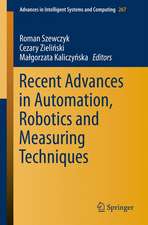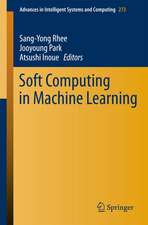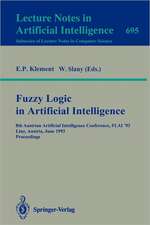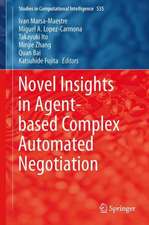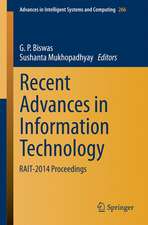Intelligent and Adaptive Educational-Learning Systems: Achievements and Trends: Smart Innovation, Systems and Technologies, cartea 17
Editat de Alejandro Peña-Ayalaen Limba Engleză Paperback – 20 sep 2014
This book is devoted to the “Intelligent and Adaptive Educational-Learning Systems”. It privileges works that highlight key achievements and outline trends to inspire future research. After a rigorous revision process twenty manuscripts were accepted and organized into four parts: Modeling, Content, Virtuality and Applications.
This volume is of interest to researchers, practitioners, professors and postgraduate students aimed to update their knowledge and find out targets for future work in the field of artificial intelligence on education.
| Toate formatele și edițiile | Preț | Express |
|---|---|---|
| Paperback (1) | 1454.25 lei 6-8 săpt. | |
| Springer Berlin, Heidelberg – 20 sep 2014 | 1454.25 lei 6-8 săpt. | |
| Hardback (1) | 1460.70 lei 6-8 săpt. | |
| Springer Berlin, Heidelberg – 11 aug 2012 | 1460.70 lei 6-8 săpt. |
Din seria Smart Innovation, Systems and Technologies
- 20%
 Preț: 601.32 lei
Preț: 601.32 lei - 18%
 Preț: 1111.97 lei
Preț: 1111.97 lei - 18%
 Preț: 1861.27 lei
Preț: 1861.27 lei - 20%
 Preț: 760.64 lei
Preț: 760.64 lei - 18%
 Preț: 1903.86 lei
Preț: 1903.86 lei - 18%
 Preț: 1236.99 lei
Preț: 1236.99 lei - 20%
 Preț: 1721.69 lei
Preț: 1721.69 lei - 20%
 Preț: 1287.78 lei
Preț: 1287.78 lei - 20%
 Preț: 1749.74 lei
Preț: 1749.74 lei - 20%
 Preț: 2221.63 lei
Preț: 2221.63 lei - 18%
 Preț: 2520.23 lei
Preț: 2520.23 lei - 20%
 Preț: 1337.27 lei
Preț: 1337.27 lei - 18%
 Preț: 1557.39 lei
Preț: 1557.39 lei - 18%
 Preț: 1123.35 lei
Preț: 1123.35 lei - 18%
 Preț: 1393.09 lei
Preț: 1393.09 lei - 20%
 Preț: 1738.54 lei
Preț: 1738.54 lei - 20%
 Preț: 2205.12 lei
Preț: 2205.12 lei - 18%
 Preț: 1226.11 lei
Preț: 1226.11 lei - 20%
 Preț: 1300.14 lei
Preț: 1300.14 lei - 20%
 Preț: 931.84 lei
Preț: 931.84 lei - 20%
 Preț: 1933.71 lei
Preț: 1933.71 lei - 20%
 Preț: 1778.85 lei
Preț: 1778.85 lei - 18%
 Preț: 1117.99 lei
Preț: 1117.99 lei - 20%
 Preț: 1759.63 lei
Preț: 1759.63 lei - 18%
 Preț: 952.09 lei
Preț: 952.09 lei - 20%
 Preț: 1762.94 lei
Preț: 1762.94 lei - 18%
 Preț: 1383.00 lei
Preț: 1383.00 lei - 20%
 Preț: 1922.18 lei
Preț: 1922.18 lei - 20%
 Preț: 1623.53 lei
Preț: 1623.53 lei - 20%
 Preț: 1623.53 lei
Preț: 1623.53 lei - 20%
 Preț: 2210.06 lei
Preț: 2210.06 lei - 20%
 Preț: 1618.60 lei
Preț: 1618.60 lei - 20%
 Preț: 1312.52 lei
Preț: 1312.52 lei - 20%
 Preț: 1310.88 lei
Preț: 1310.88 lei - 20%
 Preț: 1753.06 lei
Preț: 1753.06 lei - 20%
 Preț: 1456.88 lei
Preț: 1456.88 lei - 20%
 Preț: 1464.33 lei
Preț: 1464.33 lei - 20%
 Preț: 1627.65 lei
Preț: 1627.65 lei - 20%
 Preț: 1463.49 lei
Preț: 1463.49 lei - 20%
 Preț: 1923.82 lei
Preț: 1923.82 lei -
 Preț: 436.35 lei
Preț: 436.35 lei - 15%
 Preț: 641.71 lei
Preț: 641.71 lei - 18%
 Preț: 1413.76 lei
Preț: 1413.76 lei - 20%
 Preț: 1781.21 lei
Preț: 1781.21 lei - 20%
 Preț: 1756.37 lei
Preț: 1756.37 lei - 20%
 Preț: 1756.37 lei
Preț: 1756.37 lei - 20%
 Preț: 1634.59 lei
Preț: 1634.59 lei - 18%
 Preț: 1124.92 lei
Preț: 1124.92 lei
Preț: 1454.25 lei
Preț vechi: 1817.81 lei
-20% Nou
Puncte Express: 2181
Preț estimativ în valută:
278.28€ • 297.57$ • 232.02£
278.28€ • 297.57$ • 232.02£
Carte tipărită la comandă
Livrare economică 18 aprilie-02 mai
Preluare comenzi: 021 569.72.76
Specificații
ISBN-13: 9783642433542
ISBN-10: 3642433545
Pagini: 536
Ilustrații: XII, 524 p.
Dimensiuni: 155 x 235 x 28 mm
Greutate: 0.74 kg
Ediția:2013
Editura: Springer Berlin, Heidelberg
Colecția Springer
Seria Smart Innovation, Systems and Technologies
Locul publicării:Berlin, Heidelberg, Germany
ISBN-10: 3642433545
Pagini: 536
Ilustrații: XII, 524 p.
Dimensiuni: 155 x 235 x 28 mm
Greutate: 0.74 kg
Ediția:2013
Editura: Springer Berlin, Heidelberg
Colecția Springer
Seria Smart Innovation, Systems and Technologies
Locul publicării:Berlin, Heidelberg, Germany
Public țintă
ResearchCuprins
Part I. Modeling.- Affective Modeling for an Intelligent Educational Environment.- ALEM: A Reference Model for Educational Adaptive Web Applications.- Proactive Sequencing based on a Causal and Fuzzy Student Model.- Exploiting Learner Models Using Data Mining for E-Learning: A Rule Based Approach.- Part II. Content.- A Study of a Learning Style Index to support Intelligent and Adaptive Learning Systems.- GRAPPLE : Learning Management Systems Meet Adaptive Learning Environments.- Performance Evaluation of Decision-based Content Selection Approaches in Adaptive Educational Hypermedia Systems.- PCMAT - Mathematics Collaborative Educational System.- A Framework for Automatic Construction of Reusable Adaptive Courses: The Case of ProPer SAT 2.0.- Interoperable Intelligent Tutoring Systems as SCORM Learning Objects.- Part III. Virtuality.- Real Classrooms in Virtual Worlds: Scaffolding Interdisciplinary Collaborative Writing.- A Smart Home Lab as a Pedagogical Tool.- Supporting Hybrid Courses with Closed-Loop Adaptive Training Technology.- CELTS: A Cognitive Tutoring Agent with Human-Like Learning Capabilities and Emotions.- Part IV. Applications.- Incorporation of Agent Prompts as Scaffolding of Reflection in an Intelligent Learning Environment.- Acquisition of Higher Order Knowledge by a Dynamic Modeling Environment based on the Educational Concept of Self-Regulated Learning.- Seamless Web-Mediated Training Courseware Design Model: Innovating Adaptive Educational-Learning Systems.- Intuitionistic Fuzzy Logic-Based Approach of Intrinsic Motivation in CSCL Settings During Illusionary Sense of Control.- An Intelligent System for Modeling and Supporting Academic Educational Processes.- Intelligent Decision-Making Support within the E-Learning Process.
Recenzii
From the reviews:
“This book is a collection of 20 papers on intelligent and adaptive educational learning systems (ELSs) research, defined here as educational services for learning and teaching using artificial intelligence (AI) techniques. … The book can be seen as a snapshot of recent work in this area; this is its main merit.” (Rosa Michaelson, ACM Computing Reviews, December, 2012)
“This book is a collection of 20 papers on intelligent and adaptive educational learning systems (ELSs) research, defined here as educational services for learning and teaching using artificial intelligence (AI) techniques. … The book can be seen as a snapshot of recent work in this area; this is its main merit.” (Rosa Michaelson, ACM Computing Reviews, December, 2012)
Textul de pe ultima copertă
The Smart Innovation, Systems and Technologies book series encompasses the topics of knowledge, intelligence, innovation and sustainability. The aim of the series is to make available a platform for the publication of books on all aspects of single and multi-disciplinary research on these themes in order to make the latest results available in a readily-accessible form.
This book is devoted to the “Intelligent and Adaptive Educational-Learning Systems”. It privileges works that highlight key achievements and outline trends to inspire future research. After a rigorous revision process twenty manuscripts were accepted and organized into four parts as follows:
· Modeling: The first part embraces five chapters oriented to: 1) shape the affective behavior; 2) depict the adaptive learning curriculum; 3) predict learning achievements; 4) mine learner models to outcome optimized and adaptive e-learning objects; 5) classify learning preferences of learners.
· Content: The second part encompasses five chapters aimed to: 6) provide adaptive guidance and personalized content; 7) adaptively select learning objects; 8) collaboratively generate learning objects; 9) automatic development of reusable adaptive content; 10) deploy intelligent tutoring systems as learning objects.
· Virtuality: The third part holds four chapters dedicated to: 11) explain how Second Life was used to promote collaborative writing; 12) acquire knowledge within a smart home environment; 13) share experiences of adaptive training virtual systems; 14) reveal how an agent is used in a simulation-based tutoring system for learning the complex task of operating a robotic arm.
· Applications: The fourth part owns six chapters concerned about: 15) an agent-based way to design scaffolding to prompt reflection; 16) the stimulation of self-regulated to learn higher order knowledge; 17) aweb-mediated training system design architecture; 18) a decision making model upon the quality of the collaboration; 19) a dynamic storyboarding system to support academic process; 20) an analysis of educational and business effects of artificial intelligence application on education.
The authors, reviewers and editors of this book expect this volume is of interest to researchers, practitioners, professors and postgraduate students aimed to update their knowledge and find out targets for future work in the field of artificial intelligence on education.
This book is devoted to the “Intelligent and Adaptive Educational-Learning Systems”. It privileges works that highlight key achievements and outline trends to inspire future research. After a rigorous revision process twenty manuscripts were accepted and organized into four parts as follows:
· Modeling: The first part embraces five chapters oriented to: 1) shape the affective behavior; 2) depict the adaptive learning curriculum; 3) predict learning achievements; 4) mine learner models to outcome optimized and adaptive e-learning objects; 5) classify learning preferences of learners.
· Content: The second part encompasses five chapters aimed to: 6) provide adaptive guidance and personalized content; 7) adaptively select learning objects; 8) collaboratively generate learning objects; 9) automatic development of reusable adaptive content; 10) deploy intelligent tutoring systems as learning objects.
· Virtuality: The third part holds four chapters dedicated to: 11) explain how Second Life was used to promote collaborative writing; 12) acquire knowledge within a smart home environment; 13) share experiences of adaptive training virtual systems; 14) reveal how an agent is used in a simulation-based tutoring system for learning the complex task of operating a robotic arm.
· Applications: The fourth part owns six chapters concerned about: 15) an agent-based way to design scaffolding to prompt reflection; 16) the stimulation of self-regulated to learn higher order knowledge; 17) aweb-mediated training system design architecture; 18) a decision making model upon the quality of the collaboration; 19) a dynamic storyboarding system to support academic process; 20) an analysis of educational and business effects of artificial intelligence application on education.
The authors, reviewers and editors of this book expect this volume is of interest to researchers, practitioners, professors and postgraduate students aimed to update their knowledge and find out targets for future work in the field of artificial intelligence on education.
Caracteristici
Provides a holistic view of the computers in education paradigms and approaches Presents the underlying components of the Educational-Learning Systems Written by leading experts in the field





